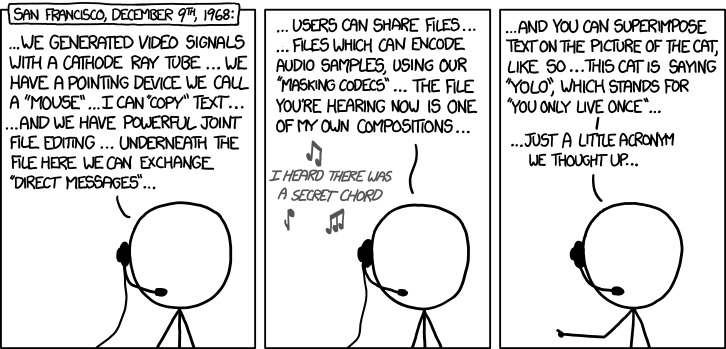CS 349 - User interfaces, LEC 001
6-15-2016
Elvin Yung
(The numbering is not a mistake. Module 7.2, Visual Perception, seems to have been removed.)
- Recall the first lecture of the course.
- Early "computers" were literally a bunch of people calculating things like
- There were some early mechanical calculators, like the Analytical Engine.
- A company called International Business Machines made the ASCC, which weighted about 11 tons - and were controlled with hundreds of dials.
-
- mid 1960s ish
- Feed instructions to computers using punch cards.
- No real interaction - the machine provides feedback in a matter of hours or days.
- The cost of getting something wrong was huge - it takes a very long time to iterate.
- 1965 - ~1985
- User types a command in a prompt, the system evaluates the command, and then provides feedback.
- You basically still had to be an expert to use them.
- e.g. Zork, Bash
- Highly flexible
- The interaction is usually well-suited to the machine, but not to the task.
- You had to learn a lot of technical concepts before understanding how to use the system.
- Requires recall rather than recognition - i.e. the interface isn't intuitive enough for a beginner to be able to figure it out. You literally had to know the command syntax to use it.
- In 1945, Vannevar Bush authored As We May Think.
- In it, he suggested the idea of a device called a memex - a tool to organize information with links between annotated pieces of content.
- Sound familiar?
- It was a futuristic vision - the technology was definitely nowhere near.
Wholly new forms of encyclopedias will appear, ready-made with a mesh of associative trails running through them, ready to be dropped into the memex and there amplified.
- Ivan Sutherland came up with Sketchpad, a device controlled with a light pen that let users directly manipulate shapes with a proto-graphical user interface.
- Under the hood, the graphics were manipulated similarly to a constraint solver.
- He was interested in building tools not for experts, but for people like artists and draftsmen. (i.e. task-driven)
- Sketchpad's software was the first to use the concept of a window.
A display connected to a digital computer gives us a chance to gain familiarity with concepts not realizable in the physical world. It is a looking glass into a mathematical wonderland.
- Career spanned 50s - 90s ish
- Led a team of researchers at the Stanford Research Institute (SRI)
- His researchers developed the beginnings of some extremely advanced technologies: mouse, hypertext, collaborative software, etc.
- Mother of All Demos - hour and a half long demo in 1968 demonstrating those technologies.
An advantage of being online is that it keeps track of who you are and what you’re doing all the time.
- Xerox PARC - worked on the Xerox Star and the Xerox Alto, the earliest personal computers with a GUI and Ethernet
- Dynabook - conceptual prototype for laptops/tablets
- Helped develop object-oriented programming (Smalltalk), Ethernet, the graphical user interfaces ...
The best way to predict the future is to invent it.
(Offhand mention that Alan Kay did an AMA on Hacker News very recently.)
-
The Xerox Star cost $75k for a basic system, $16k for each additional workstation
-
This is why you haven't heard of it.
-
Steve Jobs "steals" Xerox PARC research in exchange for pre-IPO investment in Apple
-
GUI technology gets used in the Macintosh and the Lisa
-
And the rest is history!
- Utilizes recognition rather than recall
- Better feedback
- Metaphors - interactions are more like the task domain, rather than computerese
- The GUI puts computers not just in the right hands, but in everyone's hands!
-
Touchscreen/pens
-
Natural language processing
-
Virtual/augmented reality
-
Brain (machine|computer) interface


